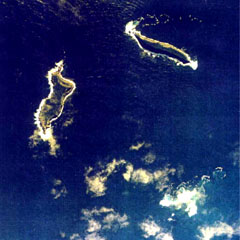Report on Hunga Tonga-Hunga Ha'apai (Tonga) — 2 February-8 February 2022
Smithsonian Institution / US Geological Survey
Weekly Volcanic Activity Report, 2 February-8 February 2022
Managing Editor: Sally Sennert.
Please cite this report as:
Global Volcanism Program, 2022. Report on Hunga Tonga-Hunga Ha'apai (Tonga) (Sennert, S, ed.). Weekly Volcanic Activity Report, 2 February-8 February 2022. Smithsonian Institution and US Geological Survey.
Hunga Tonga-Hunga Ha'apai
Tonga
20.5532°S, 175.3841°W; summit elev. 114 m
All times are local (unless otherwise noted)
On 4 February the Tonga Geological Services (TGS) posted drone footage of the Good Samaritan Beach, located on the NE side of Tongatapu, showing that tsunamis from the 15 January Hunga Tonga-Hunga Ha'apai eruption reached areas at 15 m elevation, 200 m inland. A 6 February post provided details of what happened when tsunamis reached Mango Island (75 km ENE), stating that waves 12 m high went over the church tower, reached 500 m inland, and pushed buildings and structures against the inland wall of trees. Residents fled to an area that was 30 m elevation, 700 m from the coast, and stayed there all night as ash fell. TGS noted that clean-up efforts were continuing on the islands and communications were slowly being restored.
Geological Summary. The small andesitic islands of Hunga Tonga and Hunga Ha'apai are part of the western and northern remnants of the rim (~6 km diameter) of a largely submarine caldera located about 30 km SSE of Falcon Island. The topmost sequence of welded and unwelded ignimbrite units from a caldera-forming eruption was 14C dated to 1040-1180 CE (Cronin et al., 2017; Brenna et al. 2022). At least two additional welded pumice-rich ignimbrite units and nonwelded pyroclastic flow deposits, below paleosols and other volcaniclastic deposits, indicated more very large previous eruptions (Cronin et al., 2017; Brenna et al. 2022). Several submarine eruptions have occurred at this caldera system since the first recorded eruption in 1912, including 1937 and S of the islands in 1988. A short eruption in 2009 added land to to Hunga Ha'apai. At that time the two islands were each about 2 km long, displaying inward-facing sea cliffs with lava and tephra layers dipping gently away from the caldera. An eruption during December 2014-January 2015 was centered between the islands, and combined them into one larger structure. Major explosive eruptions in late 2021 initially reshaped the central part of the combined island before stronger activity in mid-January 2022 removed most of the 2014-15 material; an even larger eruption the next day sent an eruption plume high into the stratosphere, triggered shock waves through the atmosphere and tsunami across the Pacific Ocean, and left only small remnants of the islands above the ocean surface.

